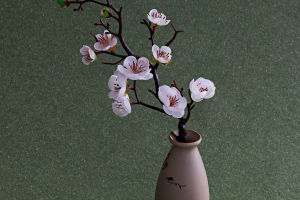Gerbera, a colorful and unique flower, belongs to the Asteraceae family and is native to South Africa.
It is widely loved for its beautiful appearance and diverse colors.
Gerbera flowers exhibit a variety of bright hues, including red, pink, yellow, orange, and white. They are often used to decorate flower beds, courtyards, and indoor spaces.
The flowers are large and flat, resembling sunflowers, and can reach a diameter of 10 to 15 cm. Their petals are stacked in multiple layers, creating a striking visual effect that often evokes feelings of happiness and warmth.
In the gardening world, Gerbera is well-known for its strong resistance to cold and diseases, making it suitable for various climatic conditions. They typically bloom in spring and summer, and they are among the most common cut flowers found in flower shops.
In the art of flower arrangement, Gerbera is often used as a focal flower and can be combined with other blooms to create a harmonious and beautiful effect. Because Gerbera has a long flowering period, if properly maintained, it can last for several weeks in a vase, which is one of the key reasons for its popularity.
In addition to their beauty, Gerbera flowers carry symbolic meanings. They are often seen as symbols of happiness and innocence and have special significance in many cultures.
Giving Gerbera flowers typically conveys blessings and love, making them suitable gifts for festive occasions such as birthdays, graduations, and weddings.
Additionally, the flower's meanings vary depending on its color: red Gerbera symbolizes love, yellow represents friendship, and pink signifies tenderness and care. Therefore, choosing Gerbera in different colors can convey distinct messages according to the occasion and mood.
When it comes to planting, Gerbera requires plenty of sunlight and good drainage. While they are not overly strict regarding soil requirements, choosing soil rich in organic matter can promote healthier growth. Gerbera thrives in warm climates, although more cold-resistant varieties can survive moderately low temperatures.
When watering, care should be taken to avoid waterlogging, as this can lead to root rot. In terms of fertilization, applying a balanced fertilizer once a month during the growing season can help the plant grow healthily. To extend the flowering period, regularly removing withered flowers is also an effective method.
Gerbera is not only an ornamental plant, but recent studies have found that it also plays a role in environmental protection. Gerbera can effectively absorb harmful substances in the air, such as formaldehyde, benzene, and carbon dioxide, thereby improving indoor air quality.
In some countries, Gerbera is promoted as an indoor green plant, particularly in office environments, as it can help relieve stress and enhance employees' work enthusiasm. Furthermore, Gerbera produces less pollen, making it suitable for individuals with allergies.
With the growing interest in gardening and plant care, Gerbera has also become a popular choice among plant lovers. Planting Gerbera in home gardens can beautify the environment and elevate one’s mood.
Whether placed on a balcony, in a courtyard, or indoors, Gerbera adds a vibrant touch to everyday life. In many countries, Gerbera is widely used in festivals, wedding decorations, and commercial activities, becoming a symbol of good wishes.
Gerbera is not just a colorful flower; it also serves as a medium for conveying emotions and blessings. Its beauty and symbolic meaning allow it to shine on various occasions. Whether one is a flower enthusiast or someone seeking to express emotions through flowers, Gerbera is an ideal choice.
By understanding Gerbera, we can not only appreciate its unique beauty but also experience the joy of living in harmony with nature. As gardening culture continues to develop, the charm of Gerbera will be further explored and celebrated.
Gerbera flowers hold a special place in the hearts of many due to their vibrant colors, unique beauty, and meaningful symbolism.
They not only brighten up spaces but also bring joy and convey emotions, making them a favorite in both gardens and floral arrangements.
Their adaptability to different growing conditions and resistance to pests and diseases further enhance their appeal to gardeners and flower lovers alike.
By cultivating Gerbera in various settings, we not only enhance our surroundings but also promote a deeper connection with nature, fostering an appreciation for the delicate balance of life and the beauty that plants can bring to our lives.


